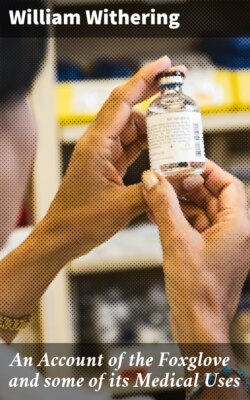Читать книгу An Account of the Foxglove and some of its Medical Uses - William Withering - Страница 4
На сайте Литреса книга снята с продажи.
INTRODUCTION.
ОглавлениеTable of Contents
The Foxglove is a plant sufficiently common in this island, and as we have but one species, and that so generally known, I should have thought it superfluous either to figure or describe it; had I not more than once seen the leaves of Mullein[1] gathered for those of Foxglove. On the continent of Europe too, other species are found, and I have been informed that our species is very rare in some parts of Germany, existing only by means of cultivation, in gardens.
Our plant is the Digitalis purpurea[2] of Linnæus. It belongs to the 2d order of the 14th class, or the Didynamia Angiospermia. The essential characters of the genus are, Cup with 5 divisions. Blossom bell-shaped, bulging. Capsule egg-shaped, 2-celled.—Linn.
DIGITA'LIS purpu'rea. Little leaves of the empalement egg-shaped, sharp. Blossoms blunt; the upper lip entire. Linn.
References to Figures. These are disposed in the order of comparative excellence.
Rivini monopet. 104.
Flora danica, 74, parts of fructification.
Tournefort Institutiones. 73, A, E, L, M.
Fuchsii Hist. Plant. 893, copied in
Tragi stirp. histor. 889.
J. Bauhini histor. Vol. ii. 812. 3, and
Lonicera 74, 1.
Blackwell. auct. 16.
Dodonœi pempt. stirp. hist. 169, reprinted in
Gerard emacul. 790, 1, and copied in
Parkinson Theatr. botanic. 653, 1.
Gerard, first edition, 646, 1.
Histor. Oxon. Morison. V. 8, row 1. 1.
Flor. danic. 74, the reduced figure.
Blossom. The bellying part on the inside sprinkled with spots like little eyes. Leaves wrinkled. Linn.
Blossom. Rather tubular than bell-shaped, bulging on the under side, purple; the narrow tubular part at the base, white. Upper lip sometimes slightly cloven.
Chives. Threads crooked, white. Tips yellow.
Pointal. Seed-bud greenish. Honey-cup at its base more yellow. Summit cloven.
S. Vess. Capsule not quite so long as the cup.
Root. Knotty and fibrous.
Stem. About 4 feet high; obscurely angular; leafy.
Leaves. Slightly but irregularly serrated, wrinkled; dark green above, paler underneath. Lower leaves egg-shaped; upper leaves spear-shaped. Leaf-stalks fleshy; bordered.
Flowers. Numerous, mostly growing from one side of the stem and hanging down one over another. Floral-leaves sitting, taper-pointed. The numerous purple blossoms hanging down, mottled within; as wide and nearly half as long as the finger of a common-sized glove, are sufficient marks whereby the most ignorant may distinguish this from every other British plant; and the leaves ought not to be gathered for use but when the plant is in blossom.
Place. Dry, gravelly or sandy soils; particularly on sloping ground. It is a biennial, and flowers from the middle of June to the end of July.
I have not observed that any of our cattle eat it. The root, the stem, the leaves, and the flowers have a bitter herbaceous taste, but I don't perceive that nauseous bitter which has been attributed to it.
This plant ranks amongst the LURIDÆ, one of the Linnæan orders in a natural system. It has for congenera, Nicotiana, Atropa, Hyoscyamus, Datura, Solanum, &c. so that from the knowledge we possess of the virtues of those plants, and reasoning from botanical analogy, we might be led to guess at something of its properties.
I intended in this place to have traced the history of its effects in diseases from the time of Fuchsius, who first describes it, but I have been anticipated in this intention by my very valuable friend, Dr. Stokes of Stourbridge, who has lately sent me the following
